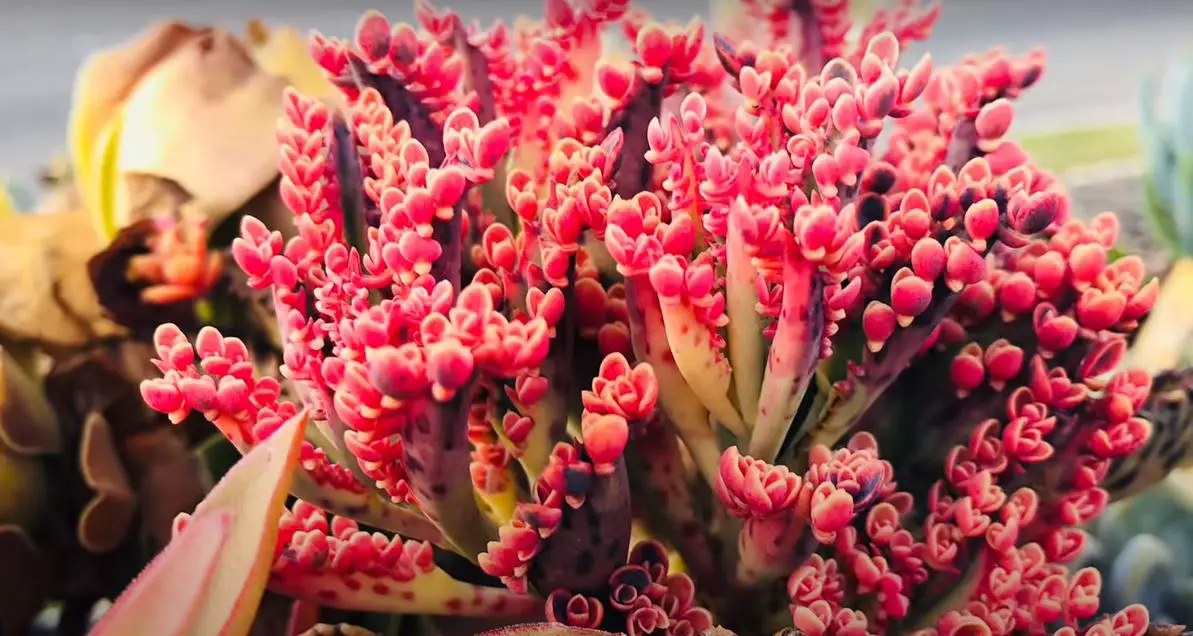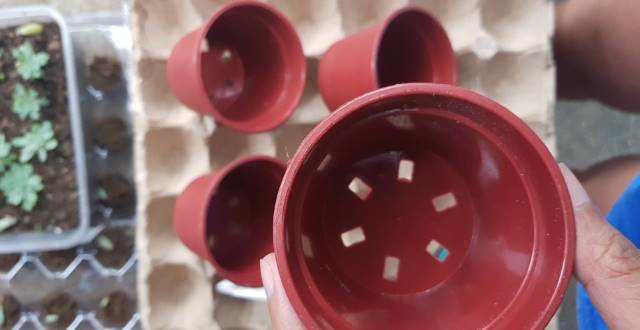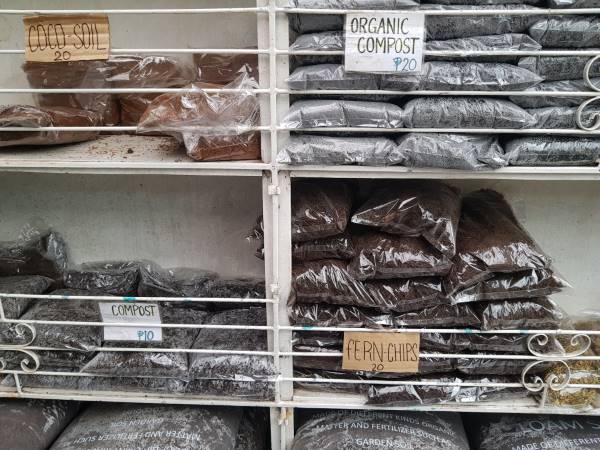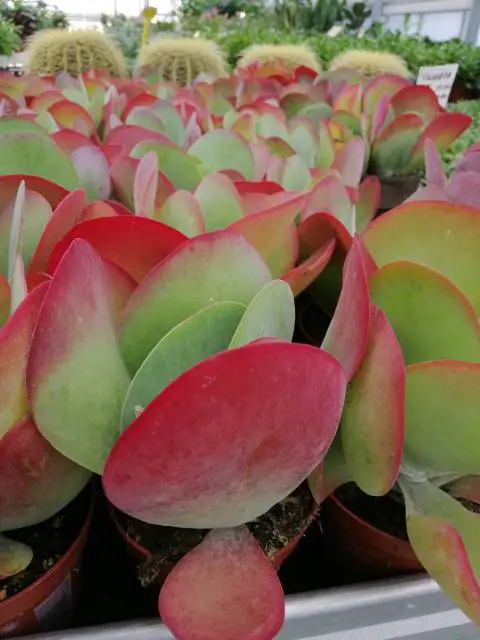Kalanchoe pink butterflies is an incredibly beautiful succulent. It is an evergreen perennial Kalanchoe succulent that is very undemanding. Kalanchoe Pink Butterflies is a variegated form of Kalanchoe × Houghtonii. The original hybrid is a cross between Kalanchoe delagoensis and Kalanchoe daigremontiana.
The primary difference between the mother plant and ‘Kalanchoe Pink Butterflies’ is that both parents of the original hybrid are viviparous (viviparous can reproduce from buds which form plantlets while still attached to the mother plant) with numerous tiny plantlets around the leaves that fall from the parent plant and start rooting. The plants give an overall pink display due to the lack of chlorophyll.
Kalanchoe Pink Butterflies is mainly grown for its attractive pink foliage. This succulent will be a great treat to Kalanchoe succulent lovers. Kalanchoe Pink Butterflies will make a great addition to succulent gardens, landscaping, and container gardens.
Common Name
Kalanchoe Pink Butterflies is also known as “Pink Mother of Thousands”. Synonyms: Bryophyllum Pink Butterflies.
General features of Kalanchoe Pink Butterflies
Kalanchoe Pink Butterflies is an attractive succulent that is grown for its beautiful colorful foliage.
Growth Habit
Kalanchoe Pink Butterflies has a long vertical stem and grows to a height of 24 to 36 inches (60 to 90 cm) and spreads 9 to 12 inches (22 to 30 cm).
Leaves
Kalanchoe Pink Butterflies has long slender leaves with tiny pink bulbils that typically resemble butterflies. The bulbils are pink because they lack chlorophyll.
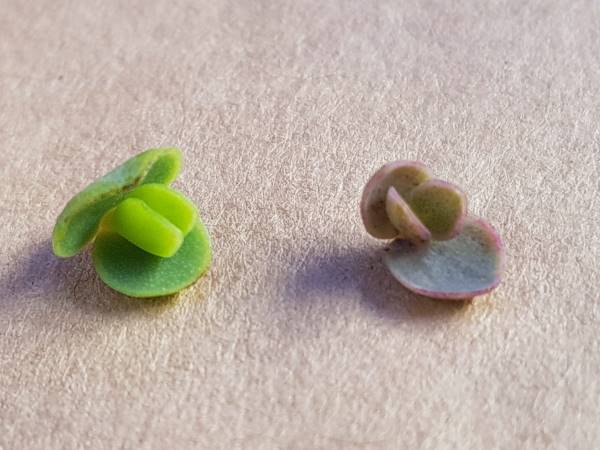
Flowers
It gives off beautiful pink flowers. Kalanchoe Pink Butterflies blooms merrily by producing enchanting pink flowers in the mid-fall.
Is it an indoor or outdoor succulent?
Kalanchoe Pink Butterflies can be grown indoors and outdoors with minimal care and attention.
How to Care for Kalanchoe Pink Butterflies?
How to prepare the potting medium?
Kalanchoe Pink Butterflies likes to grow in well-drained soil. To prepare a potting medium mix soil, compost, perlite, pumice with more sand. Perlite and sand improve the drainage of the potting mix.
You can also buy a standard succulent potting mix from the market. It will work fine for growing Kalanchoe succulents.
Light requirements
Sunlight is the most essential requirement for the growth of Kalanchoe succulents. It requires full sunlight to partial shade to grow. Indoor succulents must be kept near a bright sunny south-facing window for 5 to 6 hours a day. You can also keep the potted succulents outside for sunlight exposure in the early morning or afternoon hours when the sunlight is not too intense. Outdoor succulents should be grown in partial shade.
Avoid too much exposure to bright direct sunlight it can cause sunscald or burning of leaf tips.
Temperature
Kalanchoe Pink Butterflies prefer to grow at a warm temperature. It can’t tolerate frost. Make sure to pot Kalanchoe succulents indoors in those regions where the night temperature goes below freezing.
Kalanchoe Pink Butterflies can’t stand freezing temperatures at all. Even a few hours of exposure to below freezing temperatures can easily kill the succulents.
If you are growing Kalanchoe Pink Butterflies outdoors make sure to protect them from frost injury by using frost clothes when the temperature goes below freezing.
Hardiness zones
Kalanchoe Pink Butterflies is grown as a hardy succulent in USDA hardiness zones 9b to 11b.
- USDA Zone 9b: (25-30 °F) -3.9 to -1.1 °C
- USDA Zone 10a: (30-35 °F) -1.1 to 1.7 °C
- USDA Zone 10b: (35-40 °F) 1.7 to 4.4 °C
- USDA Zone 11a: (40-45 °F) 4.4 to 7.2 °C
- USDA Zone 11b: (45-50 °F) 7.2 to 10 °C
How to water Pink Mother of Thousands
Kalanchoe Pink Butterflies needs moderate watering. It should be watered once a week. However, the water needs vary with temperature, seasons, and variety of the succulent. In summer they need to be watered more often, while in winter they need less water.
Always water your succulents thoroughly but do not leave the soil with standing water. They can’t stand overwatering at all. Therefore, it is strictly advised to avoid overwatering as it can kill the plants. Overwatering disturbs the root system and causes disintegration and decay of the roots.
Once the root system is disturbed it will ultimately shut off the supply of water and nutrients to the plants. Nutrients and water are essential for the normal metabolic activity and growth of the succulents if their supply is hindered the succulents will ultimately die.
Though they require less water than other plants that does not mean you just forget to water them completely. They can’t tolerate a prolonged period of drought.
Make sure you water your succulents only when the top 1 to 2 inches of the soil dries out completely.
What are the signs of water distress?
Overwatered Kalanchoe Pink Butterflies will display soft, mushy, and translucent leaves. An underwatered Kalanchoe will produce shriveled, wrinkled, and flat leaves. In both underwatered and overwatered succulents leaf drop is common.
Humidity
Kalanchoe Pink Butterflies grows well at all levels of humidity. For indoor succulents, the humidity at room temperature is just fine for their healthy growth.
Does Kalanchoe Pink Butterflies need nutrition?
Kalanchoe Pink Butterflies does not need additional nutrients. The potting medium supplies plenty of nutrients for its luxurious growth.
Feed your succulents every 15 days with a balanced liquid fertilizer in the summer season. You can also use slow-release fertilizer pellets to feed your succulents.
Fertilizers will provide an extra dose of nutrients promoting better growth and blooming in the next season.
Note: Avoid excessive fertilization, it will damage the health of succulents.
How to propagate Kalanchoe Pink Butterflies?
You can multiply Kalanchoe Pink Butterflies easily by propagation.
It can be propagated by the following methods.
- Leaf cuttings
- Stem Cuttings
The chances of success by using bulbils for propagation is very low.
Unlike Kalanchoe ‘Mother of Thousands,’ Kalanchoe Pink Butterflies can not be propagated by dropping the leaflets or bulbils directly into the soil. Because the pink bulbils lack chlorophyll. It will not propagate the way a green part of succulent does. Therefore, it is preferable to use leaf and stem cutting for propagating Kalanchoe Pink Butterflies.
To take the leaf cuttings, remove the leaf from the plant in such a way that it is a clean pull and no part of it should remain attached to the plant. Set aside the cuttings at a warm dry place for a couple of days to develop callous. Avoid keeping the cuttings for too long they will lose all the moisture.
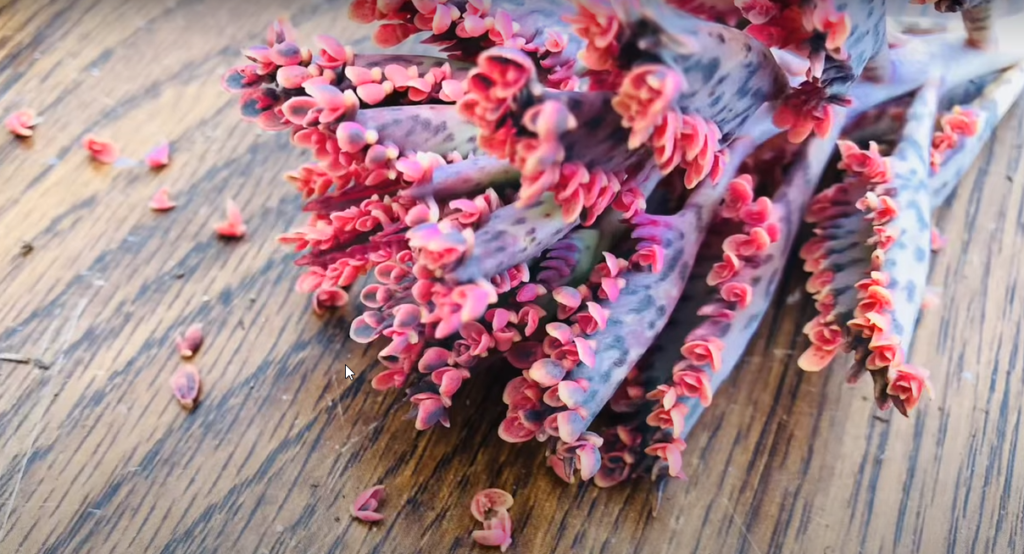
To propagate new plants, fill the pots with a cactus potting mix. Place the plant parts at the top of the moist potting soil.
Keep sprinkling water on the cuttings for the first few days to keep the soil and cuttings moist. But make sure do not overwater and also avoid exposure to direct intense sunlight.
Once the plants are established in the soil cut short the water supply and care for them like mature succulents.
How often Kalanchoe Pink Butterflies should be repotted?
As a rule, it should be repotted every 2 years. It will provide a fertile growth medium and ensure better growth of the plants.
It is also recommended to repot your succulents when:
- the growth medium has poor drainage,
- the succulent is attacked by insect pests and diseases,
- the succulent is overgrowing the container,
- When you purchase a new succulent from the market.
How to repot?
Remove the succulent from the potting medium and gently shake the succulent to remove the adhering soil and debris.
Place the plant in the new growth medium and cover the roots with the soil. Don’t water your succulent for almost a week to let the roots recover.
Once the succulent is established in the new growth medium give it proper care like a normal succulent.
How often Kalanchoe Pink Butterflies should be groomed?
You can do occasional pruning to remove dead or decayed leaves or spent blooms to encourage more blooming in the next season. Be warned to avoid excessive pruning.
How to do pruning?
Pruning is a very simple task. Just take clean gardening shears or scissors and sterilize them by rubbing with alcohol. It will reduce the risk of likely transfer of infection through contaminated tools. Gently remove the unwanted parts of the succulent.
Once you are done with pruning discard the removed parts carefully and do not leave them open in the garden soil because they will start rooting.
Which pots are suitable for growing Kalanchoe Pink Butterflies?
It is recommended to use terracotta pots or glazed ceramics with drainage holes to grow all types of Kalanchoe succulents. These pots provide exceptional results because they have good drainage and do not absorb heat.
Make sure you select a pot of right size to allow healthy root growth and spread. Do not use very small pots.
How to make Kalanchoe Pink Butterflies bloom again?
Remove the flower heads or buds at the end of the blooming season. Cut short the water supply for a while. It will allow the plant to rest for some time. Place them in a dark place for 14 hours and 10 hours light.
You Kalanchoe Pink butterflies will bloom merrily in the next season. If you follow this practice every year you can force your succulents to bloom for years.
Which insect pests or diseases attack Kalanchoe Pink Butterflies?
Mealybugs and aphids can be occasionally seen attacking Kalanchoe Pink Butterflies. To get rid of these insect pests, rub the parts of this succulent with isopropyl alcohol, or use a neem oil spray.
Avoid overwatering because they hate standing in water. Excess of water can cause root rot and encourages fungal growth on the roots.
Is Kalanchoe Pink Butterflies toxic?
Yes. All Kalanchoe succulents are poisonous to pet cats, dogs, birds, and cattle. This succulent contains cardiac glycosides that can cause health causalities in these animals. The symptoms of toxicity include excessive drooling, diarrhea, stomach upset, changes in heart rate, and rhythm.
Keep these succulents away from the access of your pet animals. In case your pet ingests a part of Kalanchoe succulent don’t wait for the symptoms to appear. Take it to the Veterinarian immediately for a complete checkup and timely remedy.
Where to buy Kalanchoe Pink Butterflies?
You can easily buy this amazing succulent from a nearby nursery or plant market. For people who like to do online shopping, they can buy Kalanchoe Pink Butterflies from Etsy, Amazon, or Mountain Crest Gardens.
Which plants are perfect to grow along with Kalanchoe Pink Butterflies?
It is a lovely succulent that can make a perfect floral arrangement with several other succulents like Echeveria, Sedum, Sempervivum, and Graptopetalum. These plants can be grown together to enhance the beauty of your gardens.
Is Kalanchoe Pink butterflies suitable for xeriscaping?
Yes. Kalanchoe pink butterflies can be grown as a xeriscape plant. It is a drought-tolerant succulent that makes it suitable for xeriscaping.
I hope this guide will help you to grow healthy and lush Kalanchoe Pink Butterflies and solve all your gardening problems.
Enjoy Planting season!

